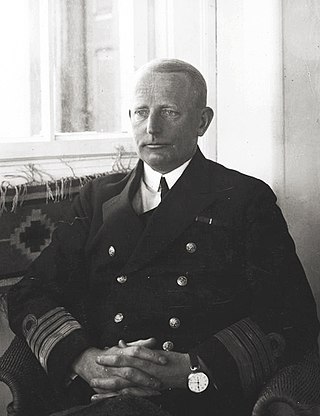Related Research Articles

Józef Unrug was a Polish admiral who helped establish Poland's navy after World War I. During the opening stages of World War II, he served as the Polish Navy's commander-in-chief. As a German POW, he refused all German offers to change sides and was incarcerated in several Oflags, including Colditz Castle. He stayed in exile after the war in the United Kingdom, Morocco and France where he died and was buried. In September 2018 he was posthumously promoted in the rank of vice admiral by the President of Poland. After 45 years his remains, along with those of his wife Zofia, were exhumed from Montrésor and taken in October 2018 to his final resting place in Gdynia, Poland.

Roman Krzyżelewski was the commander-in-chief of the Polish Navy between October 2003 and November 2007. For most of his career he was a Submarine Officer, although he started his career as a Weapons Conscript on board an Osa-class missile boat

Stefan de Walden was a Polish military commander and engineer.

Battle of Gdynia was one of the major battles in northern Poland during the Invasion of Poland of 1939. The Germans' main push towards Gdynia began on 8 September and they captured Gdynia six days later on 14 September.

The Battle of Hel was a World War II engagement fought from 1 September to 2 October 1939 on the Hel Peninsula, of the Baltic Sea coast, between invading German forces and defending Polish units during the German invasion of Poland. The defense of the Hel Peninsula took place around the Hel Fortified Area, a system of Polish fortifications that had been constructed in the 1930s near the interwar border with the German Third Reich.
Viktor Lomidze, also known by his Polish name of Wiktor Łomidze-Wachtang, was a Georgian-Polish military officer. After the Bolshevik take-over of his country in early 1920s he emigrated to Poland, where he joined the Polish Army and then the Polish Navy.

The Worek Plan was an operation of the Polish Navy in the first days of World War II, in which its five submarines formed a screen in order to prevent German naval forces from carrying out landings on the Polish coast, and to attack enemy ships bombarding Polish coastal fortifications, in particular the base on the Hel Peninsula.
Land Coastal Defence, commanded by Colonel Stanisław Dąbek, was an important unit tasked with the defence of Poland's Baltic Sea coast during the 1939 invasion.

Jerzy Włodzimierz Świrski was a Polish rear admiral and officer in the Russian Imperial Navy and later the Polish Navy. As Chief of the Polish Naval Command (1925-1947), he was a member of an elite group of high ranking Polish naval officers from foreign navies who became founder members of the re-established naval forces of the newly independent Poland after World War I. During World War II, Polish naval forces under his command, were embedded with the Royal Navy and contributed significantly to the success of Britain's maritime war effort. He notably fell out with Poland's war time Prime Minister-in-exile, General Sikorski, but was backed by the British and survived in post. He was appointed an Honorary Knight Commander of the Order of the Bath.

3rd Ship Flotilla is a tactical unit of the Polish Navy composed of 11 subunits. The unit is a main strike force of the Polish Navy, it operates various warships types such as frigates, corvettes, submarines or fast attack crafts. The main base of 3 FO is Gdynia-Oksywie Naval Base.

The 8th Coastal Defense Flotilla (Polish: 8 Flotylla Obrony Wybrzeża also known as 8th Coastal Defense Flotilla Vice admiral Kazimierz Porębski, a Polish navy fleet of coastal defense ships based in Świnoujście, one of the three naval groups of the Navy. The flotilla was established in 1965 at the main base of the Navy, previously the Szczecin Coastal Area. From January 1, 2014, the Flotilla was subordinated to the Armed Forces General Command.

The Polish Navy is the naval branch of the Polish Armed Forces. The Polish Navy consists of 46 ships and about 12,000 commissioned and enlisted personnel. The traditional ship prefix in the Polish Navy is ORP.

Zbigniew Przybyszewski (1907–1952) was a Polish military officer and a Commander in the Polish Navy. During the early stages of World War II he served with distinction as the commanding officer of the coastal artillery station at Hel Peninsula. After the war he returned to Poland from a prisoner of war camp and resumed his service, rising to the post of CO Coastal Artillery and deputy commander of the Naval Branch of the General Staff. Arrested by Stalinist authorities under false charges of espionage, he was sentenced to death in a show trial and executed.

ORP Nurek was a Polish diver depot ship from the interwar period and the beginning of World War II. Built at the Polish Navy Shipyard in Gdynia, it was commissioned in 1936 as a diver support and rescue and salvage ship, particularly for submarines. It participated in the construction of the ports in Hel and Władysławowo. The ship was bombed and sunk on September 1 in the Gdynia Naval Port; the wreck was salvaged by the Germans and scrapped.

ORP Smok was a full-sea tugboat of the Polish Navy, built in 1922 in La Rochelle, France. It sailed under various owners in France and Belgium under the names Le Boxeur and Leopold. Purchased by Poland in 1932, it served as a tugboat, training ship, and auxiliary mine-laying ship. It underwent numerous reconstructions. During the September Campaign, it transported materials from Gdynia to Hel. To block the entrance to the port in Hel, it was scuttled. It was salvaged by the Germans and, after repairs, incorporated into service under the name Rixhöft. It sailed until 1945, when it sank due to an aerial naval mine.

ORP Mewa is a Polish base minesweeper from the Cold War era, one of a series of 12 vessels of Projekt 206F, converted between 1998 and 1999 to a minehunter of Projekt 206FM. The unit measured 58.2 meters in length, 7.97 meters in width, and had a draft of 2.14 meters, with a full displacement of 470 tons. It was armed with three double sets of 25 mm 2M-3M autocannons and depth charges, and was also adapted for transporting and deploying naval mines.

ORP Flaming was a Polish base minesweeper from the Cold War era, one of 12 ships of Projekt 206F, rebuilt between 2000 and 2001 into a minehunter. The vessel measured 58.2 meters in length, 7.97 meters in width, and had a draft of 2.14 meters, with a full displacement of 470 tons. It was armed with three twin-mounted 25 mm 2M-3M automatic guns and depth charges, and was also equipped to carry and deploy naval mines.

ORP Czapla was a Polish coastal minesweeper of the Jaskółka class, referred to as a mine layer according to the nomenclature used in the Navy of the Second Polish Republic. It was built in Poland at the Polish Navy Shipyard in Gdynia as a ship of the second series of Jaskółka-class minesweepers. It was the first of three ships of this name in the Polish Navy. Although incomplete, it participated in the September campaign, during which it was sunk by German aircraft in the fishing port of Jastarnia. It was raised by the Germans, and its subsequent fate is unknown.

Submarine Squadron was a tactical unit of the Polish Navy that was part of the Fleet, established on 30 April 1932 by order no. 724 of the Chief of the Naval Command as the Submarine Boats Squadron. On 23 September 1937, the unit's name was changed to the Submarine Squadron.

The Heliodor Laskowski's Artilery Battery No. 31 (XXXI) – a four-gun coastal artillery battery of 152.4 mm caliber, positioned on the headland of the Hel Peninsula, also called the "headland battery". It was part of the Coastal Artillery Division, Hel Fortified Area. During invasion of Poland in 1939 it was a very important element of the Polish defense of the Coast.
References
This article includes a list of references, related reading, or external links, but its sources remain unclear because it lacks inline citations .(December 2014) |
- Cristino Castroviejo Vicente (2001). "The Baltic in Flames: the 1939 naval campaign". SERGA (March–April 2001): 28–37. Archived from the original on 2014-11-06. Retrieved 2006-01-03.
- Wilfred P. Deac (1996). "The Polish Submarine "Orzel"". World War II Review. 11 (No.2) (July 1996): 14–18.